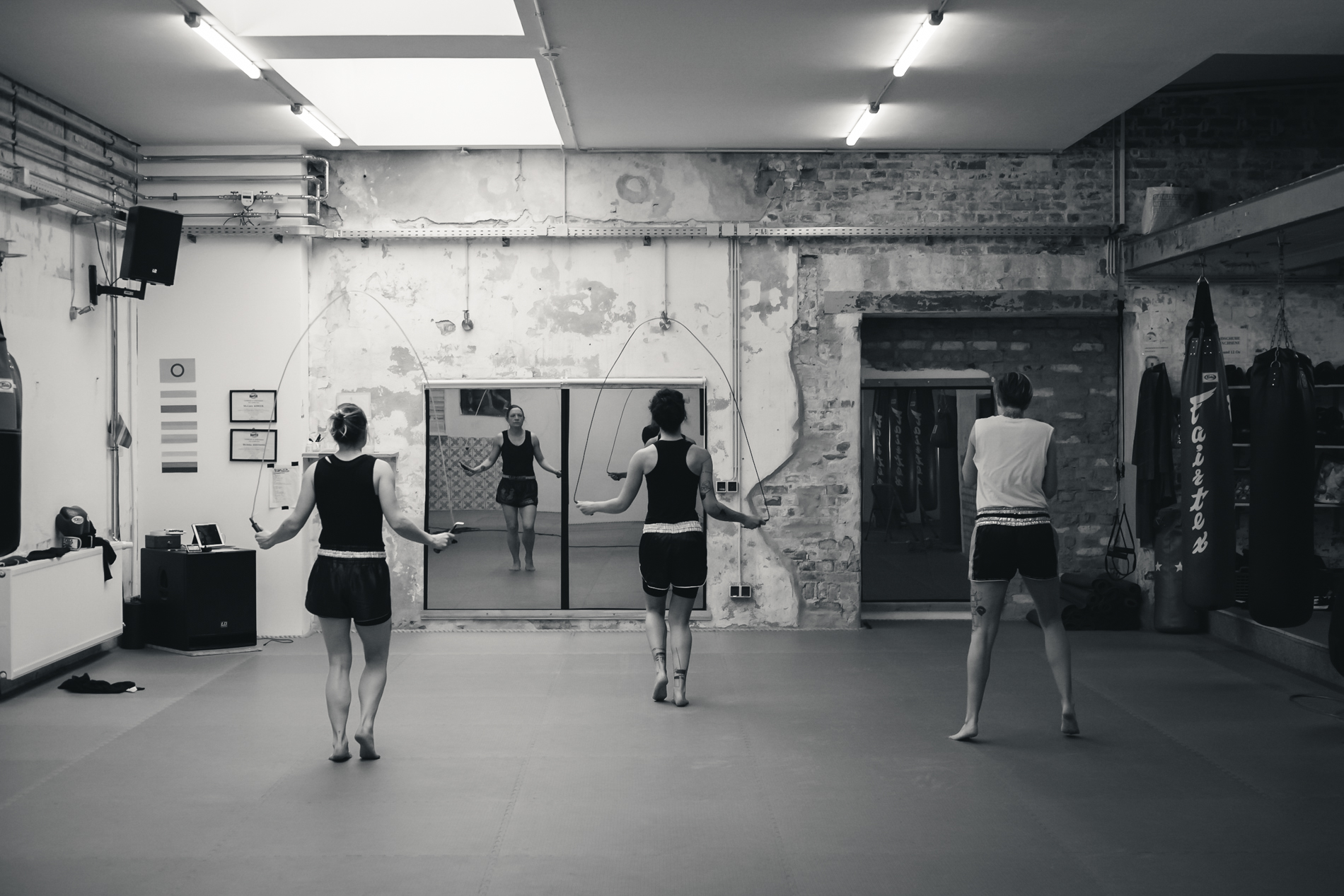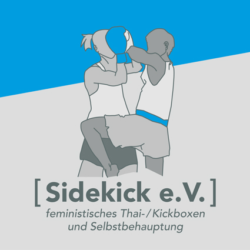Muay Thai Story
“Thai boxing consists of the qualitites of obedience, genuine knowledge, courage, endurance, patience, compassion, gratitude and honesty. If any one of these qualities is missing, to use the words ‚Thai boxing‘ is to act against the genuine art.“ (Kraitus & Kraitus: Muay Thai. The most distinguished art of fighting)
“A real boxer will never bully or intimidate anyone […] In order to be a distinguished boxer, it is imperative to look at and be aware of oneself […] One should know the weak points, important points or fatal spots.“ (Kimseng Taveesith – Boxing master during the reign of King rama VI)
Muay Thai Style 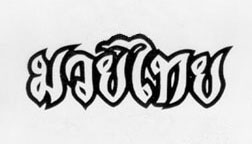
Muay Thai is the national sport of Thailand. It is a full contact sport also referred to as the “art of the eight limbs” or “art of the eight weapons” as it is characterized by the combined use of elbows, knees, legs and fists. Headbutts used to be allowed as well, but are no longer part of the sports’ set of rules. Elbows, knee techniques, kicks landed with the shin (kicks to the ribs, thighs or head) and clinching are the main features of this combat sport. Clinching is a close distance technique, allowing only elbow and knee blows. Fighters are also allowed to throw each other off balance and on to the mat.
Knees to the head are prohibited in Germany. Training takes place barefoot, wearing boxing gloves, and in some cases also wearing further protective guards.
In Thaiboxing there is a specific stance, which is one way around for a right-handed person, and the other way around for a left-handed person. Muay Thai practitioners stand with their feet shoulder-breadth apart and move only on the balls of their feet. While moving, the Thai boxer does not change the stance and takes care not to let the feet cross over. Hands are held up in front of the face to allow for defensive or offensive techniques to be thrown anytime.
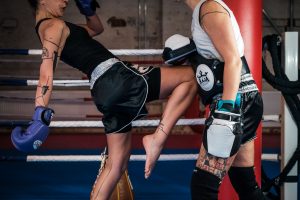 All kicks, all punches and all defensive techniques are combined with breathing techniques and draw their strenghth from the turning of the hips or whole body, allowing the whole strength of the body to be transferred into a punch or kick. It is important to learn the correct way to throw a punch, kick, elbow or knee before putting strength and speed into it. For this reason beginners in Thailand train at a heavy punching bag for years before starting to train with a partner.
All kicks, all punches and all defensive techniques are combined with breathing techniques and draw their strenghth from the turning of the hips or whole body, allowing the whole strength of the body to be transferred into a punch or kick. It is important to learn the correct way to throw a punch, kick, elbow or knee before putting strength and speed into it. For this reason beginners in Thailand train at a heavy punching bag for years before starting to train with a partner.
Muay Thai trains the ability to be exact in your movements as well as training your coordination skills, reflexes, balance, endurance, strength, speed, flexibility, sense of rhythm, the ability to make quick decisions and overcome your fears, how to deal with pain and how to breathe correctly.
More advanced Thai boxers practise by sparring. Whilst practising you wear protective gear including shin pads, knee guards, groin guards / chest protectors, gumshields, elbow pads, boxing gloves and head guards to avoid injury. You usually sparr to prepare for a fight, but sparring may also be practised for practise’s sake alone.
The history of Muay Thai
The art of Muay Thai evolved out of many different traditional Asian martial arts over a period of at least 2000 years and is strongly connected to the migration of the Thai (“the free people”) from the 12th century onwards to what is now called Thailand. It is widely assumed that the Thais fought other tribes and that Muay Thai was part of the Thai’s military or fighting training. Hereby, the body itself was used as a weapon when there were no swords or spears available.
The exact origin of Muay Thai remains unknown as most of the writings existing about it were burned in the national library at Ayuthaya in the 1767 war. However, there are pictures hewn into stone, dating as far back as 1219, depicting the Thais fighting in Cambodia. In the course of history there have been many monarchs who supported the further development of the Martial Arts. From the 17th century onwards, fights have been taking place for the amusement of the people. At the beginning boxers did not wear boxing gloves, but only hand wraps- 5 metres in length, called “Kard Cheurk”- and groin guards crafted from coconut shells. The ring was staked off with a length of cotton rope. Fighters wore the Mong-kon and Pra Jead (see below). Fights were decided by knock out (K.O.) or giving up.
Training used to consist of long distance running, swimming and punches & kicks against trees to harden shins and fists. Nutrition was mainly vegetarian. The ancient techniques were passed on through the generations, adapted and modified and slowly evolved from being a means to fight a war into the sport we know today.
In 1921 the first boxing ring was put up, measuring 6 by 6 metres on the inside, which measurement has now become the standard size ring. There were now referees in the ring, and the fight ended still by knock out or giving up. The coconut groin guard was replaced by a more stable protective guard made of cotton. For the first time the rounds had a time restriction. Before, a coconut with a hole in it had been placed in a basin of water, and the round did not end until the coconut had sunk to the bottom of the basin.
Today Muay Thai is recognized as world heritage. It is a popular sport most people in the western world train in purely for fitness reasons. In the last 50 years international rules for amateur Muay Thai have been set, and many national and international associations have been founded.
Nak Muay Ying (Female Fighters)
There is little documentation of female Thai boxers, and especially before 1997 we have to rely on oral transmission of their existance. It is to be assumed that female Thai boxers had been fighting in the provinces for a very long time, but these fights weren’t historically documented. It wasn’t until the late 1960s that Amnuay Kesbumrung, the president of the Muay Thai Institute, allowed professional women fights to take place in the famous Lumpini stadium. However, this experiment was ended only a few years later as no male spectators came to watch and support the fighters, and no one placed any bets on them. The following decades only saw female Thai boxers at village fêtes and at local temple festivals.
Around 1997, Kesbumrung then built an official stadium called Rangsit which has two rings -one for men and one for women- as well as a training camp. The 1990s also saw more and more women from the Western world coming to Thailand to fight in the country that the sport originates from. They were well trained and the Thai women, who were not, were no match for them. It is to be assumed that it was this humiliation of being beaten by foreigners in their own national sport was what sparked the fact that Thai women were now started to be trained better and their Thaiboxing skills have now greatly improved. The number of female Thai boxers is rising in Thailand as well as worldwide.
Female fighters in Thailand are usually under 18 as then is the best time for them to train and fight, during their school education period. After they leave school most of them have to go to university, work or start a family.
The hotspot for female fighters is Chiang Mai, where there are several special sports schools but also gyms just for women or with a high quota of women. The largest Muay Thai medium “Muay Siam” has a weekly column about female fighters and the Thaepae stadium in Chiang Mai has 2/7 fights between women. Sometimes they also have evenings with all-female fights.
According to the only female Muay Thai promoter there are quite a few transgender who step into the ring to be able to finance their hormone therapy. Nong Toom’s story for example is told in the film “Beautiful Boxer”. In 2017, a trans male Thai boxer was allowed to fight in the Lumpinee stadium for the very first time. But women are not allowed to fight in the most prestigious stadiums in Thailand, the Lumpinee and Rajadamnern stadiums in Bangkok at all. All the same, it is the aim of most young fighters to fight in these stadiums one day. This means for the female fighters that they can’t become as famous as the male ones, that they fight for lower titles and earn less money (about a quarter of the prize money).
In some stadiums women aren’t even allowed to touch the boxing ring as it is thought that because of their menstruation they are unclean and could “break the spell” surrounding the ring. For the same reason they have to enter the ring by going underneath the lowest rope of the ring and aren’t allowed to put on the Mongkon until they are in the ring. They are also not allowed to touch another’s Mongkon, only their own. Men are allowed to enter the ring by climbing over the highest rope.
Competitions
The influence of Muay Thai as a competitive sport particularly increased under the reign of king Rama VI, when the first stadium was built in 1921. Fighters only wore hand wraps, it was only in 1929 that the first fighter wore boxing gloves. Before the fight the competitors enter the ring wearing a headband called Mong-kon, and sporting a band around one or both of their upper arms (Pra Jead). The Mong-kon is traditionally hand- made and is supposed to protect the fighter and bring him* / her* luck. The Pra Jead used to be a strip of cloth torn from his* / her* mother’s Sarung and endowed with a prayer from a monk, for instance to grant better defense or speed, or just for luck.
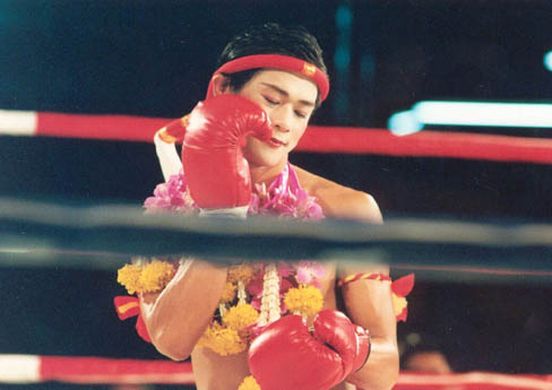 In the ring, the fighters welcome the audience and then perform a ritual that calls in mind a dance. The so-called “Wai Khruu” shows respect and gratitude towards the trainer that educated the fighter in Muay Thai, then the parents, too, are thanked- for the fighters’ life. “Wai Kruu” can roughly be translated as “to banish fear from the heart”. This dance prepares the fighters for the fight. Before the fight the Mong-kon and the Pra Jead are removed. The styles of the Wai Kruu and the Mong-kon used to provide an insight into which region the fighter originated from, but nowadays this cannot be distinguished from the garments anymore.
In the ring, the fighters welcome the audience and then perform a ritual that calls in mind a dance. The so-called “Wai Khruu” shows respect and gratitude towards the trainer that educated the fighter in Muay Thai, then the parents, too, are thanked- for the fighters’ life. “Wai Kruu” can roughly be translated as “to banish fear from the heart”. This dance prepares the fighters for the fight. Before the fight the Mong-kon and the Pra Jead are removed. The styles of the Wai Kruu and the Mong-kon used to provide an insight into which region the fighter originated from, but nowadays this cannot be distinguished from the garments anymore.
The Sarama (or Wong Pee Glong) is a rhythmic piece of music specific to Muay Thai which accompanies the Wai Khruu as well as the fight itself. In Thailand the Sarama is played by a live orchestra consisting of two flutes and two Thai drums. Playing live, the musicians can adapt to the intensity and atmosphere of the fight, playing louder and faster as the fight progresses. In large stadiums the music is replayed via loud speaker. Fights have 2-5 rounds, each lasting 2-3 minutes, depending on the league.
In Thailand, Muay Thai fighters are highly honoured and respected idols, a little like footballers in western societies. Fighters have nicknames they are awarded by their trainers after their first fight. The name recalls a specific quality the fighter has as well as the gym they train at. In Thailand Muay Thai is so popular that competitions are shown live on television several times a week. It is quite common to bet on the fighters to make the fight even more exhilarating. The fighters themselves receive a part of the bids. Many families train their children in Muay Thai from a very young age. As bets are also placed on fights with children, these often very young fighters are responsible for helping their family make ends meet. It is not uncommon for them to end their career at around 20, going on to work as a coach in a gym for Thai boxers from the West who come to train in Thailand.
References
Blog by Sylvie von Duuglas-Ittu https://8limbsus.com
https://news.muayfarang.com/2019/01/03/nak-muay-yings-female-fighters-in-thailand/
https://www.themuse.com/advice/fight-like-a-girl-the-role-of-women-in-muay-thai-boxing
http://fightland.vice.com
Panya Kraitus, Dr. Pitisuk Kraitus: Muay Thai. The most distinguished Art of Fighting
German Muay Thai Association: https://mtbd.de
https://de.wikipedia.org/wiki/Muay_Thai https://fightrr.com/muay-thai/why-do-muay-thai-fighters-wear-armbands (Anm. Angaben nicht ganz vollständig)
Like all Martial Arts, Muay Thai has been enjoying increasing popularity in feminist circles in the last years. One positive side effect of Muay Thai is that it increases body awareness and so can increase your self-confidence. In the 1980s self-organized groups started training together, and the last years have seen a considerable increase in the rise of professionally trained feminist groups in the context of various existing gyms same as several WLINTA*-only martial arts gyms.
